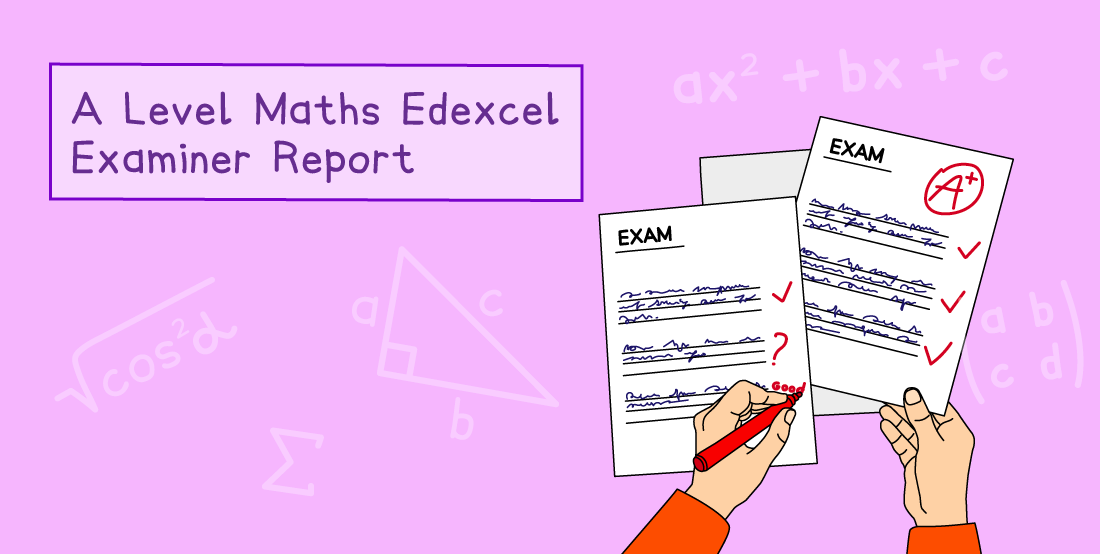A Level Maths Edexcel Examiner Report June 2023: Summary
Written by: Mark Curtis
Reviewed by: Roger B
Published

Contents
The A Level Maths Edexcel Examiner Reports for the June 2023 exams reveal that while many candidates display strong mathematical understanding, there are still recurring issues ranging from procedural errors to deeper misconceptions, resulting in lost marks.
I have condensed the findings of the examiner reports into 7 key themes that cover all papers. Each theme highlights the common errors, the causes, and some suggested strategies for improvement.
The A Level Maths Edexcel June 2023 papers, mark schemes and examiner reports can be accessed here:
Paper 1: Pure | |||
Paper 2: Pure | |||
Paper 31: Statistics | |||
Paper 32: Mechanics |
Theme 1: Applications of calculus
Topics
Differentiation, Integration, Implicit Differentiation, Parametric Equations, Modelling and Related Rates.
Common errors
Incorrect derivatives (e.g. mis‐differentiating 3x² as 5x) and integration mistakes (omitting the constant or using unnecessarily complex methods such as integration by parts).
In implicit differentiation, frequent mishandling of the product and chain rules, along with notational issues (e.g. misplaced minus signs).
In parametric problems, errors in eliminating the parameter or substituting the wrong value when finding gradients.
In modelling, mixing up rates (e.g. confusing dV/dt with dV/dh).
Causes & strategies
Causes: Rushing arithmetic steps and overcomplicating problems; insufficient review of basic calculus rules.
Exam Technique: Write every intermediate step in your working; include “= 0” on equations when needed.
Revision Tips: Practise varied problems from each calculus section; compare your solutions with model answers; keep a concise calculus rule sheet.
Theme 2: Algebraic manipulation and functions
Topics
Recurrence Relations, Sequences & Series, Exponentials and Logarithms.
Common errors
Misinterpreting notation in recurrence relations (confusing the term number n with the term value uₙ) and sign errors, especially with (–1)ᵏ.
In logarithmic questions, premature “cancellation” of logs or omission of key steps in “show that” tasks (e.g. not writing “= 0”).
Causes & strategies
Causes: Ambiguity in notation and over-reliance on memorised rules leading to incomplete working.
Exam Technique: Underline and clarify the meaning of different symbols in the question; annotate algebraic steps with the mathematical rule used, e.g. log(ab) = log(a) + log(b).
Revision Tips: Practise using recurrence relations; make flashcards distinguishing arithmetic versus geometric sequences.
Theme 3: Geometric and vector reasoning
Topics
Vectors, Circles, and related Quadratic Equations.
Common errors
In vector questions, adding rather than subtracting position vectors or neglecting a final clear conclusion on vectors being parallel.
In circle and quadratic problems, errors in completing the square (incorrect adjustment of terms) and mismatches with the prescribed format.
Causes & strategies
Causes: A lack of geometric understanding of vectors and rushing through algebraic manipulations.
Exam Technique: Clearly state a concluding remark with vector proofs (e.g. “therefore, the vectors are parallel”) and learn a step-by-step process for completing the square.
Revision Tips: Draw (or redraw) vector diagrams; compare your answer to a model solution and pay attention to the exact geometric wording of a model solution.
Theme 4: Trigonometric identities
Topics
Trigonometric Identities, Harmonic Forms, and Radians.
Common errors
Early rounding off leading to loss of accuracy (e.g. for R or α).
Working in degrees when problems require radians and leaving unknown constants in harmonic transformations.
Causes & strategies
Causes: Insufficient practice with exact trig values and a focus on speed over precision.
Exam Technique: Always confirm units at the outset; check trigonometric expressions by expanding them
Revision Tips: Solve a variety of trigonometric problems that use harmonic form.
Theme 5: Proof
Topics
Proof (including Proof by Contradiction).
Common errors
In proof questions, candidates often prove only one case or fail to state an explicit conclusion.
Presentation issues such as omitted working, inconsistent notation, or insufficient logical explanation.
Causes & strategies
Causes: Rushed reading with little planning and an incomplete development of arguments leading to lost marks.
Exam Technique: Read the problem thoroughly; list all key relationships before starting; conclude proofs with clear statements.
Revision Tips: Practise proof problems under timed conditions; check your solutions against model solutions to see if mathematical notation is being used correctly.
Theme 6: Statistics
Topics
Probability Formulas, Binomial Distributions, Large Data Set, Normal Approximation, and Hypothesis Testing.
Common errors
In probability questions (e.g. independence statements and conditional probability), many candidates misinterpret key probabilities by using incorrect denominators or misapplying formulas from the booklet.
For binomial distributions, candidates sometimes mix up event independence with constant probability or fail to present contextually complete answers.
In data analysis, errors occur with handling “trace” values, choosing incorrect denominators for standard deviation, and incorrectly truncating versus rounding answers as per instructions.
In hypothesis tests, misidentifying one-tailed versus two-tailed tests and misusing the model’s parameters (such as the mean) leading to errors.
Causes & strategies
Causes: Inconsistency in interpreting probabilistic notation and formulas, as well as insufficient familiarity with using large data sets in context.
Exam Technique: Clearly write down the formula being used; always check that the context (e.g. independence, fixed trials, consistent probabilities) is explicitly stated in your answer.
Revision Tips: Practise a range of probability and statistics questions focusing on the correct application of formulas and data interpretation; develop revision notes that clarify key differences between the conditions for a binomial distribution, and review rounding versus truncation rules.
Theme 7: Mechanics
Topics
Suvat Calculations, Variable Acceleration in 2D, Projectile Motion, Forces, Moments, and Friction.
Common errors
In suvat problems, common mistakes include arithmetic slips (e.g. using inconsistent values for acceleration or “g” where 9.8 should be used) and misapplying basic formulas such as v = u + at or s = ut + ½at² (often neglecting the initial conditions).
In vector-based motion questions, candidates sometimes fail to compute the magnitude of velocity correctly by neglecting Pythagoras’ Theorem or using incorrect components.
In questions dealing with forces and moments, errors often arise from not resolving forces (e.g. adding forces instead of resolving into components) and from inaccuracies when using the printed “show that” answers, such as not matching symbols or orders exactly.
Additional challenges are seen in applying friction equations correctly (using F = µR) and in ensuring that both calculated values and final answers are given to the correct significant figures.
Causes & strategies
Causes: Rushed application of suvat and vector equations, lack of clarity regarding initial conditions, and poor resolving of forces from complex force diagrams.
Exam Technique: Always state the key suvat equation (with the standard value for g where necessary) before plugging in numbers, and double check final answers. In force and moment problems, resolve each force explicitly and state clear reasoning for the direction of friction or reaction forces.
Revision Tips: Work on past mechanics questions with an emphasis on having a step-by-step procedure for each type of question; use a diagram to check the resolution of vectors and forces into different components, and regularly redo “show that” parts of a question to perfect the required format.
Final Thoughts
In summary, the A Level Maths Edexcel Examiner Reports from June 2023 highlight the need for students not to rush through the beginning of a question, but instead to take time to come up with a plan. Every part of the question must be addressed and full working should be given, including any concluding statements. It is a good idea to give students checklists (such as calculus rules or trigonometric identities) for them to learn. It is also important to train students to use consistent and clear mathematical notation that examiners can read and interpret without ambiguity.
Improve student outcomes with Save My Exams
Here at Save My Exams, we have concise revision notes to help your students when revising, as well as differentiated exam-style questions that could be used for homework. All our questions have student-friendly model answers to allow for easy self or peer assessment.
Sign up for articles sent directly to your inbox
Receive news, articles and guides directly from our team of experts.

Share this article


 written revision resources that improve your
written revision resources that improve your